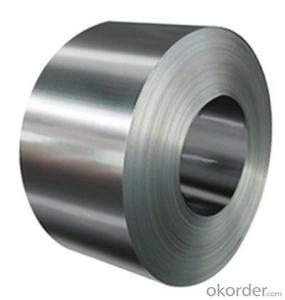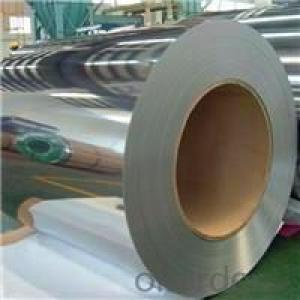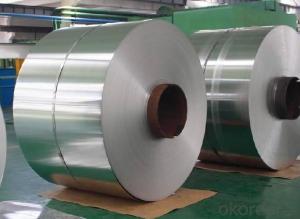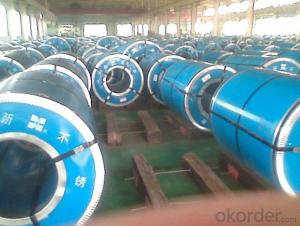Stainless Steel Coil Cold Rolled 201 J4 Surface 2B with High Quality
- Loading Port:
- China main port
- Payment Terms:
- TT or LC
- Min Order Qty:
- 100 m.t.
- Supply Capability:
- 10000 m.t./month
OKorder Service Pledge
OKorder Financial Service
You Might Also Like
1. Structure of Stainless Steel Coil Cold Rolled 201 Descriptions
Stainless Steel 201 is a new kind of Austenite stainless steel by used Mn, N replace Ni. The steel has good corrosion resistance and hot / cold processing performance, instead of 304 stainless steel products for used in the not high of corrosive environment, such as indoor, inland city outdoor etc.
2. Main Features of the Stainless Steel Coil Cold Rolled 201
Product name: Stainless Steel Coil Cold Rolled 201
Thickness: 0.2mm to 1.5mm
Technical: Cold Rolled
Width: 10mm to 1240mm
Type: 200 Series
Length: As customer's requested
Standard: JIS, SUS, AISI, ASTM
Grade: 201-J1, 201-J4, AISI201, AISI202…
Finish: BA, 2B, 8K, NO.3, NO.4, HL…
MOQ: 25 Metric Tons
Hardness: Low Hard(190 HV Max); Half Hard(240-280HV); Full Hard(42-60 HRC)
Ship Term: FOB any port, China or CFR Destination port
Delivery Time: 15 to 20 day after the receive the deposit or 100%LC
Payment Terms: TT 30% for deposit, Balance against the copy of B/L, or 100%LC
Packaging: By wooden pallet, wooden case or according to customer's request
3. Stainless Steel Coil Cold Rolled 201 Images

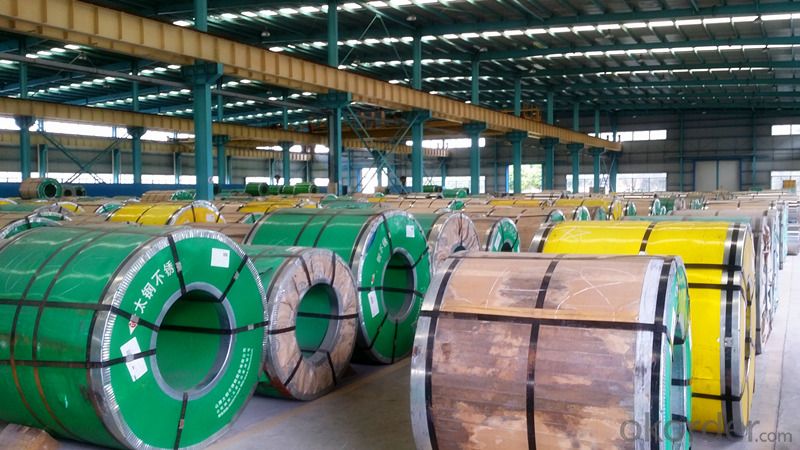
4. Stainless Steel Coil Cold Rolled 201 Specifications
Mechanical Property Contrast | YS (Mpa) | TS (Mpa) | EL(%) | HV | REMARK |
Stainless Steel 201 | 426 | 880 | 52 | 224 | 1.0t |
Stainless Steel 304 | 285 | 710 | 58 | 165 | 1.0t |
Stainless Steel 200 Series Chemicals Contrast (wt. %) | ||||||||
Chemicals | C | Si | Mn | Cr | Ni | N | Other | |
205 | 0.12-0.25 | ≤0.75 | 14.0-15.0 | 16.5-18.0 | 1.0-1.75 | 0.32-0.4 | ||
JIS, | 201 | ≤0.15 | ≤1.0 | 5.5-7.5 | 16.0-18.0 | 3.5-5.5 | ≤0.25 | - |
201L | ≤0.03 | ≤0.75 | 5.5-7.5 | 16.0-18.0 | 3.5-5.5 | ≤0.25 | - | |
202 | ≤0.15 | ≤1.0 | 7.5-10.0 | 17.0-19.0 | 4.0-6.0 | ≤0.25 | - | |
201LN | ≤0.03 | ≤0.75 | 6.4-7.5 | 16.0-17.5 | 4.0-5.5 | 0.1-0.25 | Cu≤1.0 | |
India | 201-J1 | ≤0.08 | ≤0.75 | 7.0-8.0 | 15.0-17.0 | 4.0-5.0 | ≤0.1 | Cu≤1.5 |
201-J3 | ≤0.08 | ≤0.75 | 9.0-10.5 | 14.0-16.0 | 2.0-3.0 | ≤0.15 | Cu≤2.0 | |
201-J4 | ≤0.10 | ≤0.75 | 8.5-10.0 | 15.0-16.0 | ≤1.2 | ≤0.2 | Cu≤2.0 | |
America | 204 | ≤0.03 | ≤1.0 | 7.0-9.0 | 15.0-17.0 | 1.5-3.0 | 0.15-0.3 | (Cu) |
H400 | ≤0.10 | ≤1.0 | 6.0-9.0 | 17.0-19.5 | ≤3.5 | ≤0.3 | - | |
Japan | YUS130S | 0.09 | 0.5 | 11.0 | 18.0 | 6.5 | 0.35 | - |
NTK S-4 | 0.17 | 0.43 | 14.7 | 17.7 | 1.3 | 0.35 | - | |
NM15M | 0.08 | 0.8 | 14.5 | 17.0 | 4.3 | 0.33 | - | |
Europe America | 219 | ≤0.04 | ≤0.75 | 8.0-10.0 | 19.0-21.5 | 5.5-7.5 | 0.15-0.4 | - |
Cromanite | ≤0.08 | ≤1.0 | 9.5-11.0 | 18.0-20.0 | ≤1.0 | 0.4-0.6 | - | |
201 Surface | Characteristic and Application of Stainless Steel Coil Cold Rolled 201 |
2B | The surface brightness and flatness of 2B is better than 2D then through a special surface treatment to improve its mechanical properties,2B could nearly Satisfy comprehensive uses |
No.4 | Polished with abrasive belt of grit#150#180, have better brightness with discontinuous coarse stria, but thinner than NO.3, are used as bathtub buildings inner and electrical appliances kitchen utensils and food processing. |
BA | Cold rolled, bright annealed and skin-passed, the product have excellent brightness like mirror kitchen apparatus, etc. |
8K | The product have excellent brightness and prefer bright can be the mirror. |
5. FAQ of Stainless Steel Coil Cold Rolled 201
Q: Are you factory or trader?
A: We certainly are stainless steel manufacturer and have processing plant.
Q: Can you provide mill test certificate?
A: Yes! Mill test certificate for both hot rolled raw material coils and cold rolled coils are available.
Q: Can you make DDQ (Deep drawing quality)?
A: Yes. Our material has been widely used for producing stainless steel pots and stainless steel sinks, which have strict request for good deep drawing quality.
Q: How to get a sample?
A: Free samples are available for your checking and testing. And to get free samples, please send us your detailed receiving address (including post code) and your DHL/FEDEX/UPS account for collecting samples, courier cost will be paid in your side.
Q: How about your company?
A world class manufacturer & supplier of castings forging in stainless steel, is one of the large-scale professional investment casting production bases in China, consisting of both casting foundry forging and machining factory. Annually more than 90000 tons Precision casting and forging parts are exported to markets in Europe, America and Japan. OEM casting and forging service are available, all according to customer’s requirements.
Q: How to guarantee the quality of the products?
A: We have established the international advanced quality management system,every link from raw material to final product we have strict quality test; We resolutely put an end to unqualified products flowing into the market. At the same time, we will provide necessary follow-up service assurance.
Q: How long can we receive the product after purchase?
A: In the purchase of product within 20 working days, we will arrange the factory delivery as soon as possible. The specific time of receiving is related to the state and position of customers. Commonly 20 to 40 working days can be served.
- Q:Are stainless steel strips suitable for conveyor systems?
- Yes, stainless steel strips are highly suitable for conveyor systems. Stainless steel is known for its excellent corrosion resistance, durability, and strength, making it an ideal material for conveyor systems that require continuous operation and exposure to various environmental conditions. Stainless steel strips can withstand high temperatures, moisture, chemicals, and abrasive materials, ensuring a long lifespan and minimal maintenance requirements. Additionally, stainless steel strips have a smooth surface, which reduces friction and allows for efficient material movement on the conveyor. This makes stainless steel strips a preferred choice in industries such as food processing, pharmaceuticals, automotive, and manufacturing, where cleanliness, hygiene, and product integrity are crucial. Overall, stainless steel strips offer reliability, longevity, and performance, making them well-suited for conveyor systems.
- Q:What is the maximum temperature stainless steel strips can withstand?
- The maximum temperature that stainless steel strips can typically withstand depends on the specific grade and composition of the stainless steel. However, most stainless steel strips can withstand temperatures ranging from 800 to 1600 degrees Fahrenheit (427 to 871 degrees Celsius) without significant changes to their mechanical properties.
- Q:What are the common uses of stainless steel strips in the kitchen?
- Due to their unique properties and benefits, stainless steel strips find widespread use in the kitchen. An example of this is their common application for kitchen countertops and backsplashes. With their resistance to stains, heat, and corrosion, stainless steel strips are chosen as a durable and hygienic option for food preparation areas. Another way stainless steel strips are commonly employed in the kitchen is for the construction of kitchen appliances. Manufacturers often utilize stainless steel strips to craft the outer surfaces of refrigerators, dishwashers, ovens, and microwaves. This choice is driven by stainless steel's ease of cleaning, resistance to fingerprints, and ability to lend a sleek and modern appearance to the appliances. Stainless steel strips are also utilized for kitchen utensils and cutlery. The robustness and corrosion resistance of stainless steel make it an ideal material for crafting knives, forks, spoons, and other cooking tools. Stainless steel utensils not only endure for a long time but also resist rust and staining, ensuring their longevity and maintaining their visual appeal. Moreover, stainless steel strips are frequently employed for kitchen sinks. Stainless steel sinks are highly sought after due to their durability, low-maintenance nature, and resistance to staining, heat, and scratches. They offer an easy-to-clean and hygienic surface for washing dishes and engaging in food preparation. In addition to these conventional uses, stainless steel strips can be used for shelving, kitchen cabinets, range hoods, and other kitchen fixtures. Overall, stainless steel strips provide numerous advantages such as durability, resistance to corrosion and heat, ease of cleaning, and an elegant appearance, making them a preferred choice for various kitchen applications.
- Q:Can stainless steel strips be used in the nuclear industry?
- Yes, stainless steel strips can be used in the nuclear industry. Stainless steel is often chosen for its excellent corrosion resistance, durability, and high-temperature stability, making it suitable for various applications in nuclear power plants, such as reactor components, fuel handling systems, storage containers, and radiation shielding.
- Q:What are the different types of surface treatments available for stainless steel strips?
- There are several different types of surface treatments available for stainless steel strips, each with its own unique benefits and applications. Some of the most common surface treatments include: 1. Polishing: This treatment involves mechanically smoothing the surface of the stainless steel strip to create a high-gloss finish. Polishing not only enhances the aesthetic appearance but also improves corrosion resistance and makes the surface easier to clean. 2. Brushing: Brushing involves rubbing the stainless steel strip with an abrasive material to create a brushed texture. This treatment gives the steel a distinctive linear pattern and can hide scratches and fingerprints, making it ideal for applications where a matte or satin finish is desired. 3. Passivation: Passivation is a chemical treatment that removes iron contaminants from the surface of stainless steel, enhancing its corrosion resistance. This process involves immersing the steel strip in an acid solution to remove impurities and create a passive oxide layer that protects the surface from rust and other forms of corrosion. 4. Electropolishing: Similar to polishing, electropolishing is an electrochemical process that removes a thin layer of material from the stainless steel strip. This treatment smooths the surface, reduces surface roughness, and improves the cleanliness and corrosion resistance of the steel. 5. PVD Coating: Physical Vapor Deposition (PVD) coating is a thin film deposition process that involves depositing a thin layer of material onto the stainless steel strip's surface. This treatment can provide a range of decorative and functional coatings, such as gold, black, or colored finishes, as well as enhanced hardness or wear resistance. 6. Chemical Etching: Chemical etching is a technique that uses chemicals to selectively remove material from the stainless steel strip's surface. This treatment allows for the creation of intricate designs or patterns on the steel and is commonly used for branding or decorative purposes. 7. Powder Coating: Powder coating involves applying a dry powder onto the stainless steel strip's surface and then heating it to form a protective layer. This treatment provides excellent corrosion resistance, durability, and can be customized with different colors or textures. It is important to consider the specific requirements and intended use of the stainless steel strip when selecting a surface treatment, as each treatment offers different properties and finishes that can enhance the overall performance and appearance of the steel.
- Q:What are the main properties of 111 stainless steel strips?
- The main properties of 111 stainless steel strips include high corrosion resistance, excellent mechanical properties, and good formability. These strips are made from austenitic stainless steel, which contains high levels of chromium and nickel. The high chromium content provides superior resistance to corrosion, making it suitable for various applications in industries such as automotive, aerospace, and construction. Additionally, 111 stainless steel strips possess excellent mechanical properties, such as high tensile strength and good impact resistance. This makes them ideal for applications that require strength and durability. Moreover, they exhibit good formability, allowing for easy shaping and fabrication into desired forms or components. Overall, 111 stainless steel strips offer a combination of corrosion resistance, mechanical strength, and formability, making them versatile and widely used in various industries.
- Q:Are stainless steel strips suitable for heat treatment processes?
- Yes, stainless steel strips are suitable for heat treatment processes. Heat treatment is a common process used to modify the physical and mechanical properties of metals, including stainless steel. By subjecting stainless steel strips to controlled heating and cooling cycles, it is possible to alter their hardness, strength, and other properties to meet specific requirements. Heat treatment processes such as annealing, quenching, tempering, and precipitation hardening can be applied to stainless steel strips to improve their machinability, formability, and resistance to corrosion. However, it is important to consider the specific grade and composition of stainless steel being used, as some grades may have limitations on the extent of heat treatment that can be applied. Consulting with a metallurgist or material specialist is recommended to ensure the appropriate heat treatment process is selected for specific stainless steel strips.
- Q:Are stainless steel strips suitable for industrial ovens?
- Yes, stainless steel strips are suitable for industrial ovens. Stainless steel is a highly durable and heat-resistant material that can withstand high temperatures typically found in industrial oven environments. It is also resistant to corrosion and oxidation, making it ideal for prolonged exposure to heat. Additionally, stainless steel strips are easy to clean and maintain, making them a practical choice for industrial oven applications.
- Q:Can 111 stainless steel strips be used in the chemical processing industry?
- Yes, 111 stainless steel strips can be used in the chemical processing industry. 111 stainless steel is a low carbon variation of the 300 series stainless steels, which are known for their excellent corrosion resistance properties. This makes them suitable for use in environments with high levels of chemicals and corrosive substances. Additionally, 111 stainless steel strips possess good strength, toughness, and formability, making them ideal for various applications in the chemical processing industry, such as tanks, pipes, valves, and other equipment. However, it is important to consider the specific requirements and conditions of a particular chemical processing operation to ensure that 111 stainless steel is compatible and appropriate for the specific application.
- Q:Are 111 stainless steel strips suitable for heat recovery systems?
- 111 stainless steel strips are not typically suitable for heat recovery systems. Heat recovery systems require materials that can withstand high temperatures and have good heat transfer properties. While stainless steel is known for its corrosion resistance, it may not have the necessary thermal conductivity or tolerance for high temperatures that are crucial for heat recovery systems. It is advisable to consult with a professional engineer or specialist in heat recovery systems to determine the most suitable materials for your specific application.
1. Manufacturer Overview |
|
|---|---|
| Location | |
| Year Established | |
| Annual Output Value | |
| Main Markets | |
| Company Certifications | |
2. Manufacturer Certificates |
|
|---|---|
| a) Certification Name | |
| Range | |
| Reference | |
| Validity Period | |
3. Manufacturer Capability |
|
|---|---|
| a)Trade Capacity | |
| Nearest Port | |
| Export Percentage | |
| No.of Employees in Trade Department | |
| Language Spoken: | |
| b)Factory Information | |
| Factory Size: | |
| No. of Production Lines | |
| Contract Manufacturing | |
| Product Price Range | |
Send your message to us
Stainless Steel Coil Cold Rolled 201 J4 Surface 2B with High Quality
- Loading Port:
- China main port
- Payment Terms:
- TT or LC
- Min Order Qty:
- 100 m.t.
- Supply Capability:
- 10000 m.t./month
OKorder Service Pledge
OKorder Financial Service
Similar products
New products
Hot products
Hot Searches
Related keywords
